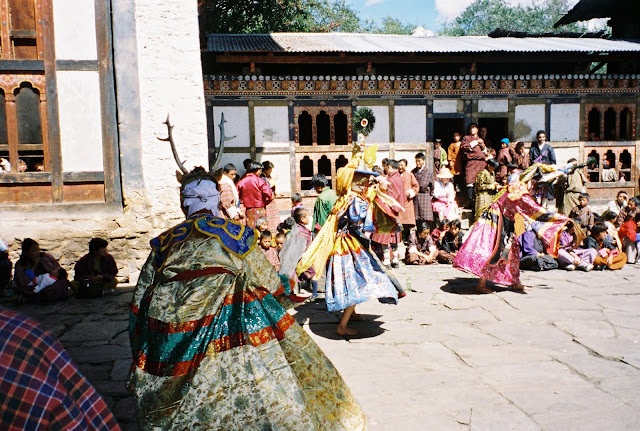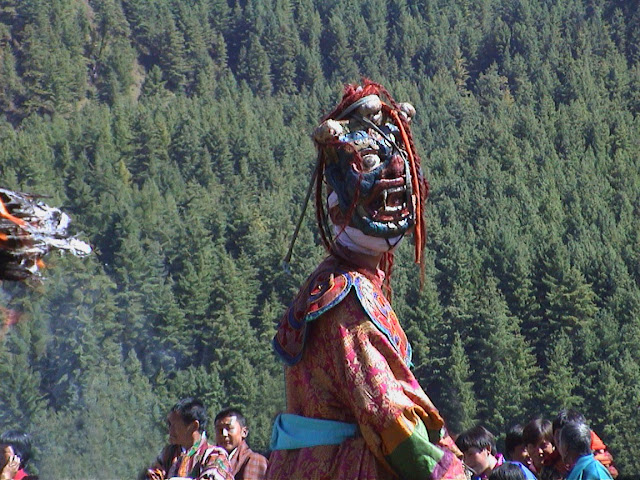Bhutan, Druk Yul (Land of the Dragon), is a Himalayan kingdom of deep cultural traditions, serene people, and outstanding mountain scenery. I traveled there in October 2000, with a small group of adventure travelers led by Max Holland, owner of the Middle Path tour company. Here are some scenes, events, and people I saw in my travels to this mountain paradise. The short clip shows some of the festival activities we saw.
 |
Thimphu Black Hat Ceremony |
After an exciting landing in Paro, we toured the beautiful river valley, visited the Dzong (Bhutan monastery and administrative center) and museum. All along the way, the villagers were busy harvesting the barley and the red Bhutan rice and putting up the red peppers on their rooftops to dry. We also took a hike through the barley fields and visited with some villagers along the way.
Many of the homes we saw along our river walk were lavishly decorated with various fertility signs including erect penises. Their birth rate is about 18 per thousand compared to the US birth rate of 12.5 per thousand so it looks like these fertility signs are working just fine.
We traveled to Thimphu where we witnessed the annual Thimphu Tshechu Festival which honors Guru Rinpoche who was an Indian saint that brought Buddhism to this region around 800 AD. The dances by the monks included the Black Hat Dance, Black Hat Dance with Drums, and the Dance of the Stag.

Here we visited the Punakha Dzong which turned out to be closed to outside visitors as most are except for festivals or if you are conducting official business.
The monks were very friendly and welcomed us to their monastery along with the view of the terraced valley below.
Passing through Trongsa, we arrived at Jakar and began our four-day stay at the beautiful stone crafted Young Felt Guest House. Here the owner and son are greeting us.
I am relaxing while waiting for my stone heated bath.
Near the guest house, these girls invited a few of us to their homes to visit their grandfather who was a festival mask maker. We ended up buying a few of the masks from him and got to see how the local people lived.
We also visited the cheese factory, a yarn factory, and the market square where we saw the King’s entourage drive by on his way to visit the monastery, the Queen's residence, schools, apple growers, and the cheesemakers.
Here is a happy monk waiting for the King's arrival.
Along with his more serious buddies.
This Jakar Gate was decorated for the King's Visit where we found the happy monk waiting for his arrival.
We saw more farmers drying out their chilies throughout Jakar.
During the festival period, we were able to visit the Queen's residence.
We then had the rare privilege of attending one of Bhutan’s colorful festivals at the Thankabi Goemba, a small village just outside Jakar. To get there, we crossed a foot suspension bridge over a crashing, green-white river, and then walked about two miles to the small village Dzong.
We gave a ride to these three monks who were also heading to the small village where we would see another Black Hat dance festival.
When we first arrived our local guide took on the challenge of carrying this large rock around this pole. None of us took on this challenge.
After the rock carry, this girl helped us find places to watch the Black Hat ceremony and in exchange, we helped her with her English which all children now learn at school.
Again the monks performed the Black Hat Dance which is a ground purification rite designed to conciliate the malevolent beings of the ground in order to stay at the Dzong and village. The black hat dancers assume the presence of yogis who have the power of killing and recreating life.

This dance was followed by the Fire Dance (Me-Wang) in which two large stakes of buckwheat stalks are piled up close together and lit. Villagers—and some foreigners—try and run through the passage of fire, thereby washing away their sins.
Before I visited Bhutan, I didn't even know it was a country. Still, only about 150,000 tourists explore Bhutan per year. Very few backpackers find their way here because Bhutan requires tourists to spend $250 per day on accommodations and tours. Why stay in a hostel for $250 per day? If you plan on visiting Bhutan, be sure to go when there are festivals so you can enter the Dzongs which contain both governmental and religious functions.
The cost of this tour to Tibet, Nepal, and Bhutan including airfare was $7,000 or about $318 per day for the 22-day trip.
My favorite tour company, Crooked Trails, provides tours there during the festival times for about $3,500 for a 12-day visit. Flights are not included, but a large portion of the cost is a charitable deduction. Check it out at :
http://crookedtrails.org/trips/bhutan-cultural-immersion-and-the-paro-festival/
The cost of this tour to Tibet, Nepal, and Bhutan including airfare was $7,000 or about $318 per day for the 22-day trip.
My favorite tour company, Crooked Trails, provides tours there during the festival times for about $3,500 for a 12-day visit. Flights are not included, but a large portion of the cost is a charitable deduction. Check it out at :
http://crookedtrails.org/trips/bhutan-cultural-immersion-and-the-paro-festival/
Subscribe to my YouTube Channel
I have recently uploaded all of my travel videos to YouTube now that they allow longer uploads. I have also added other shorter travel videos.
That link is https://www.youtube.com/c/huntforgold
If you do go there, please subscribe to my video channel since it will help me eventually get some income there and help with my future travels.














































No comments:
Post a Comment